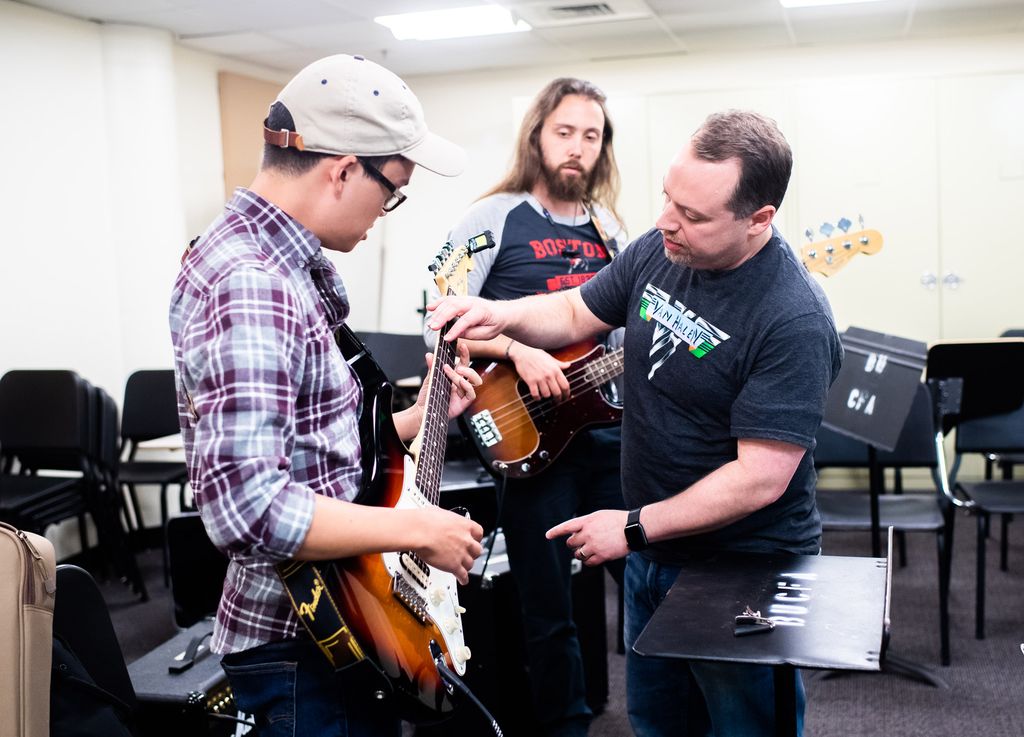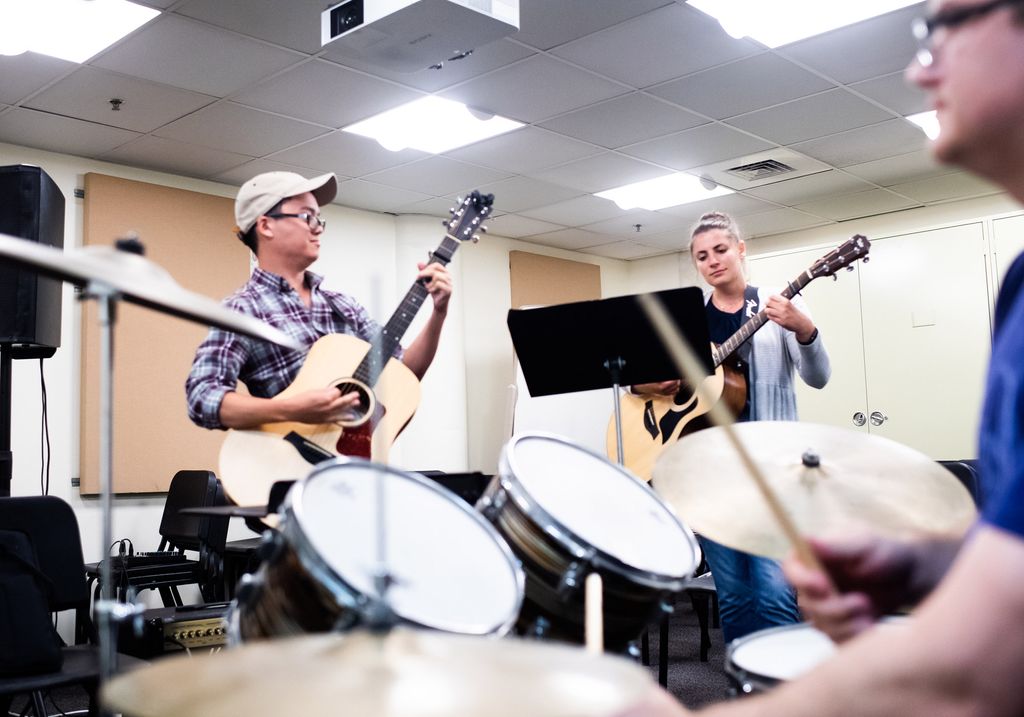Teaching Music Teachers How to Rock
In the video above, music teachers taking the weeklong CFA class Rock Band Performance & Pedagogy talk about why they’re learning to rock out—and why it’s important to music education.
Teaching Music Teachers How to Rock
Weeklong CFA summer workshop blends history, theory, and pedagogy with band practice
Alice Cooper got it wrong: forget “School’s Out”—this summer, school was in at BU for teachers who wanted to learn how to rock.
Many junior high and high schools include the basics of rock ’n’ roll as part of their musical education. And while some music teachers know Nirvana’s “Smells Like Teen Spirit” backwards and forwards, many others come up through orchestra or jazz band or chorus and don’t know a Stratocaster from a Les Paul or Eddie Van Halen from, well, Les Paul.
The latter group is the target audience for Rock Band Performance & Pedagogy, a College of Fine Arts Summer 2 course taught by Jay Dorfman, a Kent State University associate professor and coordinator of music education, and his friend Kevin Coyne, a music teacher at McDevitt Middle School in Waltham, Mass.
“I started a rock band camp about 15 years ago with a friend who was a drummer, with my guitar students and his drum students,” says Coyne (CFA’21), who’s working on a doctorate in music education. “It took off. I ran it for about 12 years, and it’s still continuing without me. And in the process of doing that I became friends with Jay, who suggested doing a professional development class for teachers who wanted to do what we did. It’s not something that a lot of teachers get formal training in, in music education.”
“I was a music education faculty member here at BU for eight years,” Dorfman says. “I had been becoming more and more involved in the movement of bringing rock bands to schools, which is really a national movement at this point, or international. And it’s always more fun to teach intense workshops like this collaboratively.”
The course, offered every other summer, consists of five days of history, theory, and pedagogy, taught mostly in the mornings, followed by rock band practice in the afternoons. The week culminates in a performance for family and friends at BU Central.
The 11 students in this year’s class included 9 music teachers from different grades and a couple of ringers who had personal reasons for wanting to rawk. Many were grad students in CFA’s music education program. They spent a lot of time learning such things as the difference between guitars like the Fender Stratocaster and the Gibson Les Paul and the history of rock ’n’ roll and how it emerged from forms like the blues.
“Many of us are classically trained musicians, and we did not have a lot of experience playing rock band instruments,” says trombonist Burton Hable (CFA’23), a doctoral student in music education who has taught music to middle- and high-school students for more than a decade.
Learning requires being willing to make mistakes, and Coyne and Dorfman had hopes that their own fledgling drum solos and possible headbanging would help their students overcome any self-consciousness.
For teachers with rock experience, learning rock-specific pedagogy is more important, from helping students figure out the right instruments for themselves to picking tunes for class or lessons.

Primarily a drummer, Matthew Paquette taught guitar, piano, and the history of rock ’n’ roll at a high school in his native Rhode Island until he was laid off earlier this year. “My experience in rock ’n’ roll has always been playing it, and it’s one thing to be able to do something and another to be able to teach it,” says Paquette, who expects to return to the classroom soon. “I took this class particularly to find out: how am I going to prep my lessons? How am I going to find the repertoire that I need to select?”
The trick, he’s learned, is to find stuff that’s edgy enough to count as rock and keep students interested, but isn’t laced with graphic language that will upset administrators or parents.
“You don’t want it to turn into a prohibition in your town,” says Dorfman.
“Like Footloose,” Coyne adds.
For rehearsal, the students split into two groups so they can get their ya-yas out. Sorta.
“I never held one of these before,” says Alexandra Papantonis (Wheelock’19, CAS’19), one of four women in the class, as she strums random notes on a Stratocaster. “I feel so powerful.”
Papantonis is one of the ringers, a linguistics student who’s finishing up some credits this summer. But she is also a skilled beatboxer and electronica performer who wants to get into music production. A classically trained flutist, she decided she needed some experience with guitar-based rock.
“You’re going to play something called a D chord,” Paquette, who’s playing bass at the moment, tells her. “Take your third finger and put it on the third fret…”
Down the hall, a quintet is already playing a serviceable version of the Beatles’ “Cry Baby Cry,” but here, six students tackle “Sugar, We’re Goin’ Down” by Fall Out Boy. Several of them are on instruments they’ve literally never touched before this moment. And only one or two really know the song, so they pull it up on phones and iPads to learn their parts.

“Hardly any of the students actually play as their principal instruments the things they’re playing this week,” says Dorfman. But to have a functioning band in class, the teachers need to be able to instruct budding bassists, drummers, guitarists, keyboard players, and singers. “We’re teaching them foundational techniques that they can bring back to their students,” he says.
Many of the students were a little tense when the end-of-week performance began, but cut loose on numbers like the Joe Cocker arrangement of “With a Little Help from My Friends,” by the Beatles. “That one felt the best,” Hable says. “People were really getting into it, not going, ‘Oh my gosh, I’m on a secondary instrument I don’t know that well.’ They were having fun, doing what we came here to do.”
“It helps put them in the role of the students, in the mind-set of what their students would be going through,” says Coyne. “How are you going to work with kids and get them to sing if you are afraid to do it yourself?”
“I didn’t think I was going to like it going in, but then I really liked it,” Papantonis says of her time strumming the Strat. “It wasn’t the best-sounding thing in the world, but it was certainly a lot better than I would have expected from myself.”
Later, she experimented with one of the Stratocaster’s lesser-known features, called a vibrato arm, or more commonly, a whammy bar, which bends the strings for expressive effect.
“You whammied!” Paquette tells her, which is generally agreed to be a rock-school breakthrough.



Comments & Discussion
Boston University moderates comments to facilitate an informed, substantive, civil conversation. Abusive, profane, self-promotional, misleading, incoherent or off-topic comments will be rejected. Moderators are staffed during regular business hours (EST) and can only accept comments written in English. Statistics or facts must include a citation or a link to the citation.